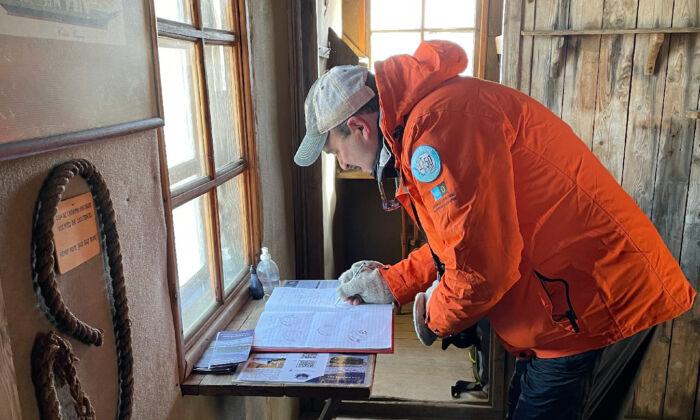After years of consideration—and several COVID delays—my husband and I decided this was the year to attack our bucket lists with vigor. At the top of my list was a trip to Italy full of culture, wine and history. My husband’s was literally the polar opposite: He wanted us to explore Antarctica. It wasn’t something I had ever thought about, but we had made a pact, so we booked the trip.
Antarctica is warmer than our northern home in January, so we chose that month to thaw out on the White Continent with a National Geographic expedition that promised opportunities to have close encounters with penguins and glaciers. To be safe, we packed long underwear and heated socks with our waterproof pants and boots for wet landings from Zodiac boats. A National Geographic parka with cozy liner was included in our trip.
We flew overnight from Atlanta to Buenos Aires, where our first activity was a brief overview of the city. That evening we met up with our fellow explorers to learn about the next steps of our journey and have dinner before falling into bed.
Our 3:30 a.m. wakeup call got us rolling for the flight that took us to Ushuaia in Tierra del Fuego, the southernmost city on the planet. There we boarded coaches and toured the Tierra del Fuego National Park as we learned about the area’s history and landscape. Then we boarded a catamaran on which we lunched and cruised through the Beagle Channel back to the dock where the National Geographic Explorer awaited us in Ushuaia. By early afternoon we were casting off and waving at the last people, cars, buildings and trees we would see for the next 10 days.
Our voyage had favorable winds for the two-day trip across the Drake Passage, so guests bonded and laughed as we lurched around getting our sea legs.
Evenings consisted of daily recaps, weather forecasts and cocktails in the lounge before creative and varied meals in the dining room.
Once we arrived in Antarctica, our days became so adventure-filled that they ran together. A map in the appropriately named Chart Room was updated daily to show our progress. Our first entry was a stop at Brown Bluff, a place where there were too many penguins to go ashore, so we took Zodiac rides along glaciers and through small icebergs near shore and got our first whiff of pungent penguin poo. We learned that the fragrant feces are an easy way to spot a penguin colony from afar because they are always pink, the color of the krill the birds rely on for sustenance. True to form, there was a pink tint to the snow on which the squawking birds wandered, argued, rested and fed their chicks.
Leopard seals floated on ice nearby. The colonies for them are bountiful buffets where they can fill their bellies on fresh penguins that are forced to pass them in search of food. On shore, penguin parents take turns with the chicks. One parent stays to feed the baby—up to 40% of their own body weight in regurgitated krill—while the other braves the waves to swim out for a refill. Often the birds approach the water in large groups to push past the danger zone and will leap out of the water to gain speed as they catch a quick breath. The result is a sea that pops with penguins coming and going from the colony. Two lucky Zodiacs provided safe refuge for penguins who decided to leap right up and into them.

The staff worked hard to find shelter from winds that threatened to foil our Zodiac trips and other planned activities. In Croft Bay they settled into a place that has not been available to any ship before because it has always been frozen. While we kayaked among icebergs and took a plunge in the below-freezing water, the crew sent out Zodiacs to map the bay and found that previous explorers had miscalculated the shoreline because it had always been covered with snow.
Another day we visited a shack on Snow Hill Island that had once provided shelter to six researchers from Sweden who became stuck there in 1902 for 22 months before being rescued. The tiny shack is now a testament to the Heroic Age of Antarctic Exploration. Orange tents near the shack are home to Argentinian researchers who work there now.
On Deception Island we hiked up the side of a volcanic crater. We had previously learned about the first planes in Antarctica that had launched from this island’s curved runway and the active volcanoes that made long-term structures impossible. That evening we saw footage that the crew’s divers had taken of massive bone piles that remain on the bay’s floor from the active whale- and seal-hunting teams that had also once stationed there.
There were more penguin colonies to walk through where birds inspected us curiously. We also found waterfalls at which to marvel, whales to photograph and opportunities to take in the massive ice structures that float silently by in places that only two years ago were frozen solid.

Our crossing back to Argentina was more of a “Drake Shake” than our gentler southbound passage had been, and when we arrived it was a shock to see people, cars, buildings and stoplights. But memories of the peace on Antarctica remain, and with them a renewed sense of how important it is to protect this special place.
National Geographic Explorer goes off the beaten path for true expeditions. They partner with Lindblad Expeditions, but for the best service contact Natural Habitat Adventures to book the trip: www.nathab.com





